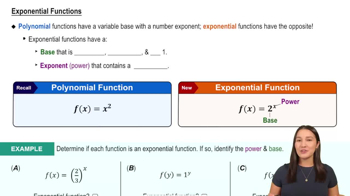Table of contents
- 0. Functions7h 52m
- Introduction to Functions16m
- Piecewise Functions10m
- Properties of Functions9m
- Common Functions1h 8m
- Transformations5m
- Combining Functions27m
- Exponent rules32m
- Exponential Functions28m
- Logarithmic Functions24m
- Properties of Logarithms34m
- Exponential & Logarithmic Equations35m
- Introduction to Trigonometric Functions38m
- Graphs of Trigonometric Functions44m
- Trigonometric Identities47m
- Inverse Trigonometric Functions48m
- 1. Limits and Continuity2h 2m
- 2. Intro to Derivatives1h 33m
- 3. Techniques of Differentiation3h 18m
- 4. Applications of Derivatives2h 38m
- 5. Graphical Applications of Derivatives6h 2m
- 6. Derivatives of Inverse, Exponential, & Logarithmic Functions2h 37m
- 7. Antiderivatives & Indefinite Integrals1h 26m
- 8. Definite Integrals4h 44m
- 9. Graphical Applications of Integrals2h 27m
- 10. Physics Applications of Integrals 2h 22m
4. Applications of Derivatives
Differentials
Problem 87
Textbook Question
Two methods Evaluate the following limits in two different ways: Use the methods of Chapter 2 and use l’Hôpital’s Rule.
lim_x→0 (e²ˣ + 4eˣ - 5) / (e²ˣ - 1)
 Verified step by step guidance
Verified step by step guidance1
First, let's evaluate the limit using algebraic manipulation. Start by substituting x = 0 directly into the expression to check if it results in an indeterminate form. Substitute x = 0 into the expression (e^(2x) + 4e^x - 5) / (e^(2x) - 1).
Notice that substituting x = 0 gives us (1 + 4*1 - 5) / (1 - 1), which is 0/0, an indeterminate form. This suggests that we can use algebraic techniques or l'Hôpital's Rule to evaluate the limit.
For the algebraic method, consider expanding e^(2x) and e^x using their Taylor series expansions around x = 0: e^(2x) ≈ 1 + 2x + 2x^2/2 and e^x ≈ 1 + x + x^2/2. Substitute these approximations into the original expression.
Simplify the expression using the Taylor series expansions: (1 + 2x + 2x^2/2 + 4(1 + x + x^2/2) - 5) / (1 + 2x + 2x^2/2 - 1). Simplify the numerator and the denominator separately.
Now, let's use l'Hôpital's Rule. Since the limit is in the form 0/0, differentiate the numerator and the denominator with respect to x. The derivative of the numerator e^(2x) + 4e^x - 5 is 2e^(2x) + 4e^x, and the derivative of the denominator e^(2x) - 1 is 2e^(2x). Evaluate the limit of the new expression as x approaches 0.
 Verified video answer for a similar problem:
Verified video answer for a similar problem:This video solution was recommended by our tutors as helpful for the problem above
Video duration:
8mPlay a video:
Was this helpful?
Key Concepts
Here are the essential concepts you must grasp in order to answer the question correctly.
Limits
Limits are fundamental concepts in calculus that describe the behavior of a function as its input approaches a certain value. They help in understanding the function's behavior near points of interest, including points where the function may not be explicitly defined. Evaluating limits is essential for determining continuity, derivatives, and integrals.
Recommended video:

One-Sided Limits
L'Hôpital's Rule
L'Hôpital's Rule is a method for evaluating limits that result in indeterminate forms, such as 0/0 or ∞/∞. It states that if the limit of f(x)/g(x) leads to an indeterminate form, the limit can be found by taking the derivative of the numerator and the derivative of the denominator separately. This rule simplifies the process of finding limits in complex functions.
Recommended video:
Guided course

Power Rules
Exponential Functions
Exponential functions, such as e^x, are functions where a constant base is raised to a variable exponent. They are characterized by their rapid growth and unique properties, such as the fact that the derivative of e^x is e^x itself. Understanding exponential functions is crucial for evaluating limits involving expressions like e²ˣ and eˣ, as they often appear in calculus problems.
Recommended video:

Exponential Functions







